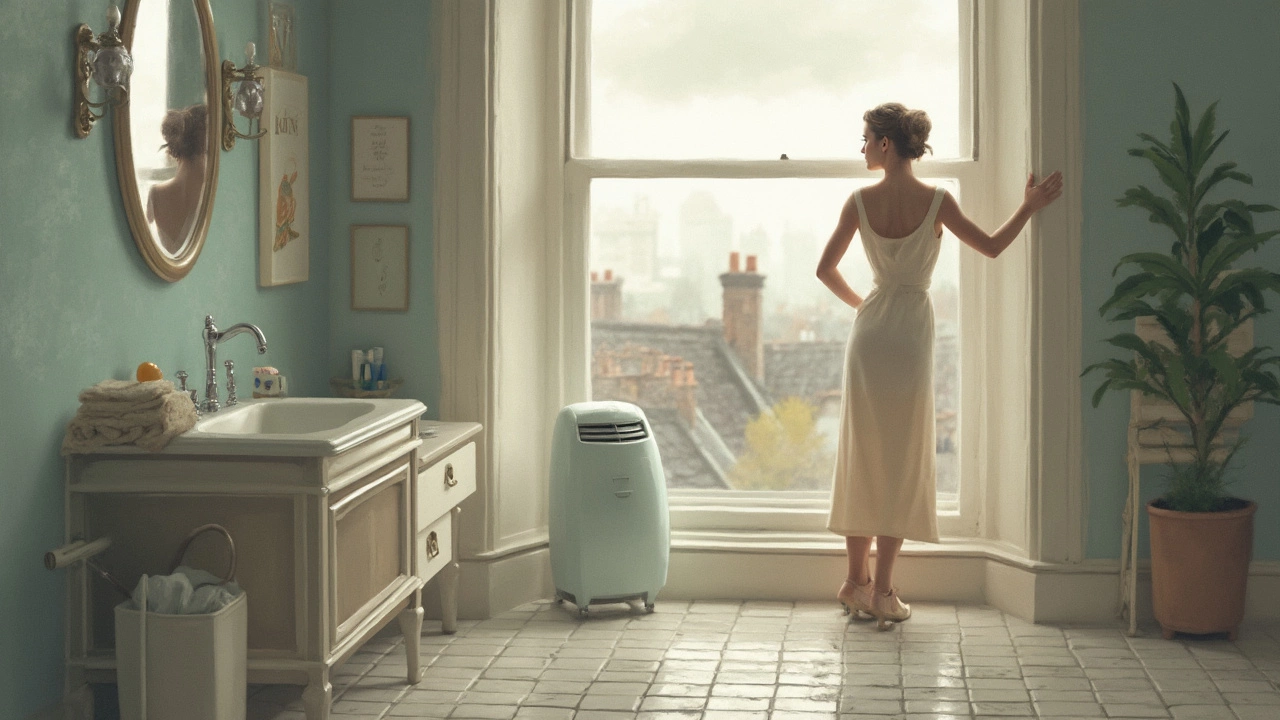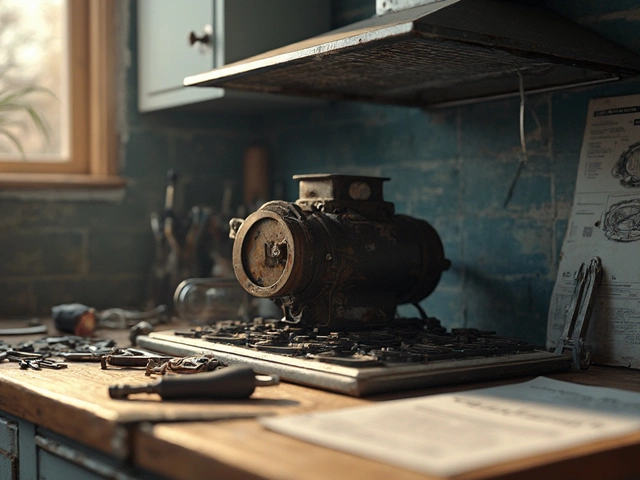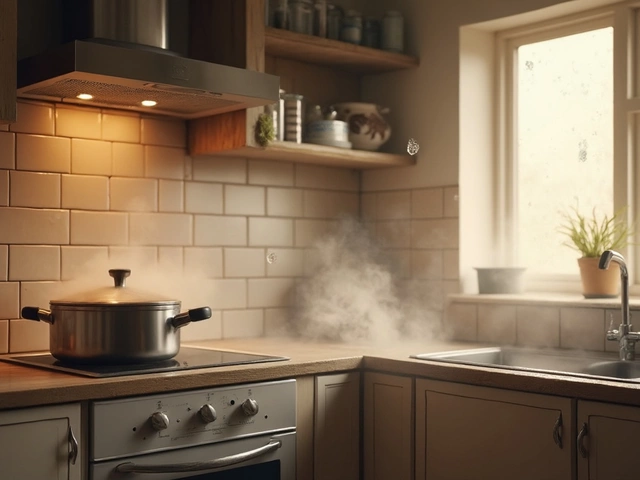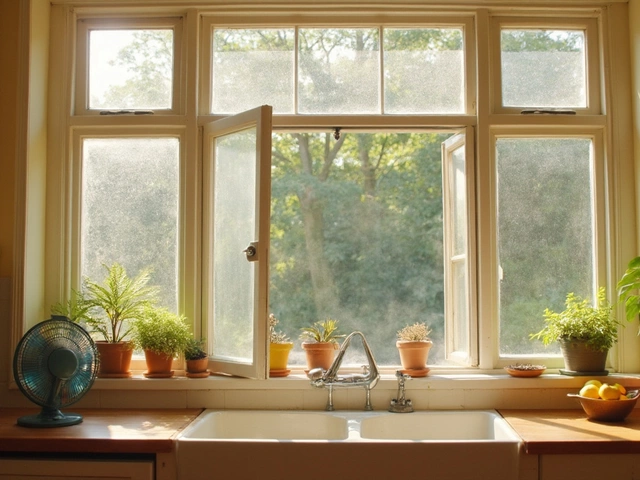So you wake up one morning and realize your extractor fan is totally dead. Maybe it’s blowing a fuse every time you switch it on, or it just groans before going silent. Your kitchen or bathroom starts to feel damp, stale, and you can’t shake off the lingering smell of last night’s curry. Sounds familiar?
You don’t have to breathe in stuffy air or let mold get the upper hand. There are some easy tricks and workarounds that can help you out until you get the fan fixed—or even skip the fan altogether in some cases. From old-school habits to handy gadgets you’d find at the hardware store, there’s more than one way to push that air out and bring in some fresh breeze.
First things first: look at what you already have, like opening windows, using portable fans, or even playing with cross-ventilation. Don’t have a window? No worries—there are a few other moves you might not have tried yet. Let’s run through the smartest ways to keep your space dry, fresh, and breathable—without having to rely on a broken fan.
- Why Extractor Fans Matter
- Simple Ventilation Hacks
- Gadgets and Tools That Work
- Long-Term Fixes and Smart Habits
Why Extractor Fans Matter
If you’ve ever wondered why people make a fuss about extractor fans in kitchens and bathrooms, here’s the deal: these little gadgets do a lot more than just blow air around. They’re your main defense against humidity, bad smells, mold, and even fire risks. That’s right—moisture and smells aren’t just annoying. Without proper ventilation, you end up with sticky surfaces, peeling paint, persistent odors, and even mold spores that can mess with your health.
In the kitchen, ventilation is your ally against smoky air, greasy buildup, and leftover smells from things like fried bacon or burnt toast. In bathrooms, extractor fans fight off condensation, which pops up every time you take a hot shower. No extractor? You’re basically rolling out a welcome mat for mold and mildew. According to the UK Health and Safety Executive, damp air and mold can trigger asthma and allergies in anyone, not just people with weak immune systems.
Here’s a quick look at what happens in rooms with and without proper ventilation:
| With Extractor Fan | Without Extractor Fan |
|---|---|
| Removes fumes and steam fast | Steam lingers, making air humid |
| Prevents mold and mildew | Walls, ceilings, and grout get moldy |
| Gets rid of lingering food and bathroom smells | Odors hang around a lot longer |
| Helps paint and furniture last longer | Peeling paint, warped wood, rust |
It’s simple: an extractor fan saves you from headaches—sometimes literally. People often blame cracked walls or flaking paint on poor DIY jobs, but usually it’s a buildup of moisture from the lack of an extractor fan. These fans also cut down on the smoke alarm going off when you char your toast, which in my house usually sends my dog Muffin running for cover.
So, if your extractor fan is busted, you’re missing more than just a creature comfort. You’re basically opening the door for a pile of problems, from smelly air to expensive repairs down the road.
Simple Ventilation Hacks
If your extractor fan just stopped working, there are some no-fuss fixes you can try right away. Most people overlook how much fresh air they can get with just a few tweaks to their daily routine.
First off, open a window—even if it’s just a crack. It sounds basic, but fresh air is your best friend when you’re fighting off smells or steam from cooking or showers. Position the window farthest from your main source of steam and, if possible, prop the bathroom or kitchen door open at the same time. This creates a straight path for air to move. Got an interior bathroom? Sometimes, just leaving the bathroom door open for a while after showering helps more than you’d think.
Switch on any portable fans you have and point them towards an open window. The idea is to move the damp or smelly air outside. Fans can also blow fresh air into the room, which helps push out the gross air sitting inside. If you set up one fan to blow out by a window and another in a doorway to push fresh air in, you’ll get pretty impressive results even without a built-in fan. Here’s a quick how-to:
- Open a window as wide as you can.
- Place a portable fan facing outwards in the window to exhaust air.
- If you’ve got two fans, position the second one in the doorway, facing in, to bring in new air.
- Keep doors between rooms open for better flow.
If you’re dealing with a kitchen, remember to put lids on your pans when you’re boiling water. It cuts down steam by up to 30%, and that’s less moisture hanging around. Wiping down surfaces after you cook or shower also helps keep the air drier, so mold and odors don’t get a chance to build up.
Don’t forget about timing. Try to ventilate during dry, mild weather since humid outside air can actually make things worse. Here’s a table showing how much of a difference simply opening a window can make:
| Ventilation Method | Air Exchange Rate (per hour) |
|---|---|
| Closed Windows/Doors | 0.2–0.5 |
| Single Window Open | 3–5 |
| Windows & Doors Open (Cross-ventilation) | 8–12 |
Don’t underestimate these small changes. They’re not just a stopgap—they can genuinely keep your air fresh while you sort out the real ventilation fix.

Gadgets and Tools That Work
If your extractor fan is down for the count, there’s no reason to just live with stuffy air and fogged-up windows. Let’s get practical: a few simple gadgets can almost mimic what a fan does, or sometimes do even better for certain jobs.
First up, the humble portable fan. A regular box fan or even a standing oscillating fan can help move air around the room and out a window. The trick? Point one fan out the window to blow old, damp air outside, and, if possible, place another at the other end of the room pulling fresh air in. This boost of cross-ventilation can actually get rid of odors and steam pretty fast.
- Dehumidifiers: These things suck up moisture from the air, which cuts down condensation and helps stop mold. They’re especially handy if you’ve got no windows or vents. In a small bathroom, even a mini desktop dehumidifier can make a big difference after a shower.
- Air purifiers: While they don’t get rid of moisture, air purifiers with HEPA filters handle dust, smells, and some airborne nasties. If you’re mainly fighting musty smells (hello, old apartments), plug one of these in and you’ll notice the difference.
- Window fans: These fans actually sit in the window frame and pull air outside or bring it in, depending on which way you turn the blades. Great for kitchens where cooking smells linger.
If you’re looking for how well these options stack up, check out this quick comparison:
| Tool | Tackles Moisture | Reduces Odors | Portable |
|---|---|---|---|
| Portable Fan | No | Yes (via air movement) | Yes |
| Dehumidifier | Yes | No | Yes |
| Air Purifier | No | Yes | Yes |
| Window Fan | Somewhat | Yes | Yes |
If you’ve got a bit of DIY spirit, you can also use a cheap venting kit (the kind for tumble dryers) to help pull air out through small windows or vents. It isn’t pretty, but it works in a pinch.
With tools like these, you don’t have to just wait around for a repair guy to show up. Even Muffin, my dog, seems to appreciate the fresher air after a quick blast from a dehumidifier. Give some of these gadgets a shot and see which combo gives your place that fresh, breathable feel again.
Long-Term Fixes and Smart Habits
If you’re tired of wrestling with mold or sticky air because your extractor fan is always breaking, it’s time to think about solutions that actually stick. Even small changes in your routine or setup can make a massive difference down the road—and they’ll save you the headache of always running after a repair guy.
First up: if you’ve got windows, start making it a habit to keep them open during or right after showers, cooking, or even laundry. Cross-ventilation is a game changer. If you can open windows on opposite ends of a room or house, do it. That alone can drag stale air out and let fresh air rush in. I do this at home when I make bacon, and Muffin (my dog) seems to appreciate it too.
If your bathroom or kitchen never seems to dry out, look into installing a trickle vent. These small vents let air out all day, every day, but without the draft. They’re not expensive and can be fit above windows in a couple of hours.
Got a decent budget? This is where you can win big. Consider adding a heat recovery ventilator (HRV) or a mechanical ventilation system. These setups pull out humid, smelly air and bring in fresher air, making your place healthier. According to a 2023 Home Ventilation Survey, homes with HRVs had up to 50% less condensation and musty smell complaints compared to those relying on windows alone.
| Solution | Upfront Cost | Main Benefit |
|---|---|---|
| Trickle vent | $30-$60 | Low-cost, easy airflow |
| Heat Recovery Ventilator (HRV) | $800-$2,000 | Filter air, remove moisture |
| Cross-ventilate with windows | Free | No equipment, works fast |
But let’s not underestimate habits. When you cook, use lids on your pots as much as possible—traps steam and stops it from floating up. Wipe down your shower walls after every use to keep wet surfaces from attracting mold. Make it a family game: who can get the bathroom dry the fastest?
- Keep windows cracked after cooking or showering.
- Use a squeegee on tiled walls to kick out leftover water.
- Tackle spills or leaks right away to keep humidity down.
- Dry laundry outdoors or in a room with airflow.
Finally, remember to keep furniture a little away from walls—just a couple inches. This lets air move around and stops damp spots from forming. These fixes are cheap, and the habits are easy to make part of your regular routine. And hey, your house will thank you for it, trust me.




